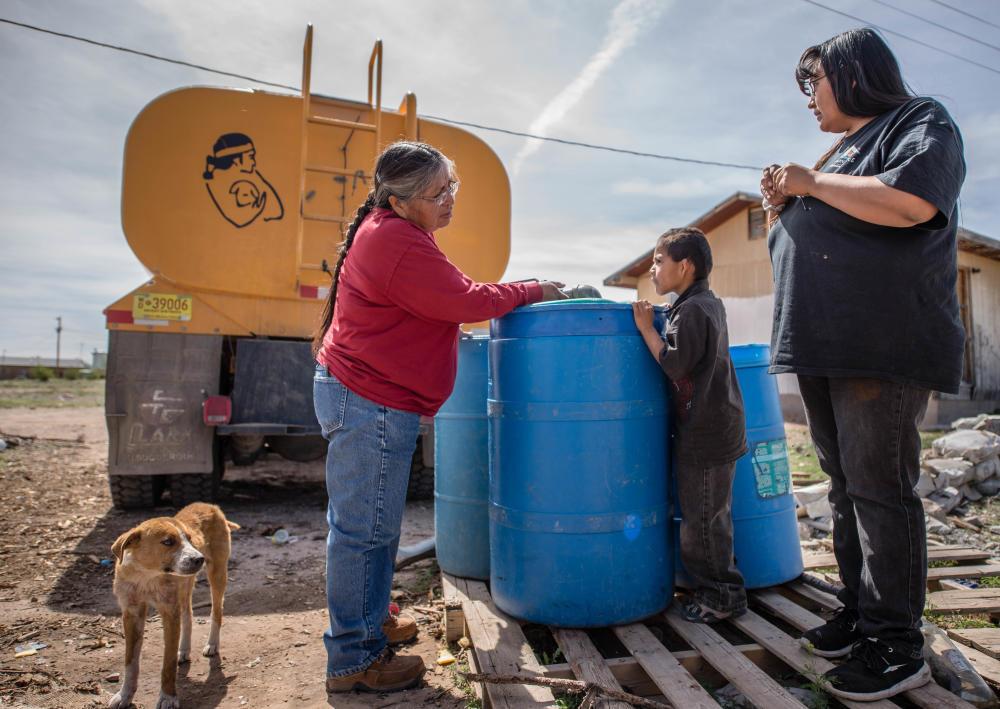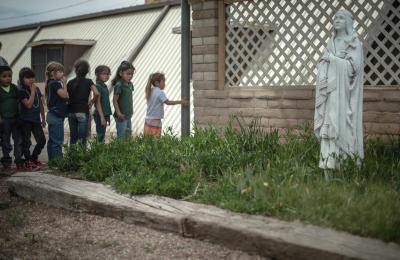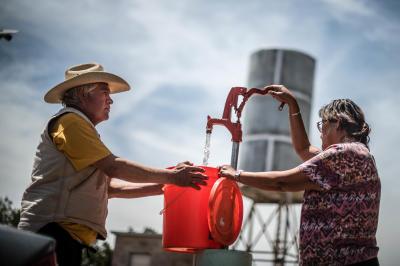|
Bankruptcy case could leave hundreds without water
By Olivier Uyttebrouck
THOREAU – Darlene Arviso is a grandmother, school bus driver and silversmith, but to hundreds of people in this southeastern corner of the Navajo Nation, she is “the water lady.” At 8 a.m. each weekday, after she drops off a busload of children at the St. Bonaventure School, Arviso cranks up a heavy-duty Chevrolet truck and fills its 4,000-gallon water tank at a well owned by the St. Bonaventure Indian Mission. For the next seven hours, she bounces over rutted, dirt roads, covering some 300 miles a week, delivering water to people who lack services most Americans take for granted, including electricity and running water. As she pulls up outside a house, residents quickly emerge with barrels, jugs, even a large cooking pot – anything that will hold the precious liquid. “These people really depend on the water truck,” especially the elderly and those who lack transportation, she said, tearing up as she described the living conditions of some families and children she serves. “That’s why I love my job.” As harsh as life is for Navajo families here, Arviso and others fear the worst because the St. Bonaventure Indian Mission and School has become entangled in a bankruptcy case filed by the Diocese of Gallup. A judge this year approved a plan to appraise several properties, including St. Bonaventure’s land in Thoreau, as a possible source of funding to pay for a bankruptcy reorganization plan. The Diocese of Gallup in 2013 became the nation’s ninth Roman Catholic diocese to file for Chapter 11 bankruptcy protection in response to a growing number of lawsuits filed by alleged victims of sexual abuse by priests. Attorneys for both the victims’ committee and the diocese agreed that certain “key properties,” including the St. Bonaventure property, could be “liened, liquidated or otherwise used” to fund a settlement plan, according to court records. ‘Sort of an oasis’ “Depending on where this goes, we could lose the mission and the school,” said Chris Halter, executive director of St. Bonaventure Indian Mission and School. Mission property includes the well that offers the only free water source for hundreds of families. “I do feel that this threat is very real.” An Albuquerque firm in March appraised about 40 acres in Thoreau, including land occupied by St. Bonaventure School, which this year enrolled 215 students in pre-kindergarten through eighth grade. The school charges no tuition and provides two free meals a day for children who too often live in broken homes plagued by poverty and violence, Halter said. “We’re sort of an oasis where kids can come and get two meals a day and an education,” he said. “The problem is, it’s up to the bankruptcy court what is going to be done. What we’re going to look like at the end of this, I don’t know.” St. Bonaventure employs 65 people, of whom 55 are Navajos, making it one of the area’s largest employers, Halter said. St. Bonaventure’s fate could be determined at a mediation scheduled June 9-10 in Phoenix. U.S. Bankruptcy Court Judge David Thuma has ordered all parties in the bankruptcy to participate, including St. Bonaventure, the Diocese of Gallup and an attorney representing 57 people who claim they were sexually abused by priests. The settlement will also need to pay for legal and professional fees that total at least $1.86 million. The diocese has identified a former director of St. Bonaventure as one of 31 diocesan employees, including 29 priests, against whom there have been credible allegations of sexual abuse of a minor. The diocese removed the Rev. Douglas McNeill as head of St. Bonaventure in 1994 after an Albuquerque attorney filed a lawsuit alleging McNeill sexually abused a high school boy in Thoreau. The diocese settled the lawsuit in 1995 by paying an undisclosed amount to the former student, according to news reports. McNeill’s whereabouts are unknown. The court-ordered appraisals also included the St. Bonaventure Indian Mission offices, where the mission maintains a well and water tank where Arviso fills her water truck each day, and where hundreds of area residents drive for miles to fill containers with safe drinking water. No animosity On a recent morning, Colin Welletto and Kyle Begay drove 10 miles to the mission, where they filled four 55-gallon barrels in the back of a pickup. Welletto said his family has access to a shallow well but, like most wells in the area, the water is contaminated and suitable only for livestock. “You can use it for showers, but it’s not good for drinking,” he said. Other appraised properties include two mobile home parks managed by Bonaventure that provide affordable housing for about 170 families and a thrift store intended to provide low-cost used clothing for those in need. The Diocese of Gallup provides no financial support for the mission or the school, Halter said. Private donations pay for St. Bonaventure’s $4 million annual budget, he said. “We don’t have any animosity with the diocese,” he said, “but when you are at risk of losing 40 years of legacy and everything that we’ve built here because of this bankruptcy, that’s when it gets frustrating.” St. Bonaventure and its attorney, Charles Hughson of Albuquerque, filed a legal complaint in Thuma’s court last year contending that the diocese conveyed to the school a deed for the Thoreau property in 1992. St. Bonaventure later withdrew the complaint. Hughson has said that the withdrawal of the complaint “wasn’t in any way a concession that its land belonged to the diocese.” A spokeswoman for the Diocese of Gallup referred questions to its attorney, Susan Boswell of Tucson, Ariz., who said she couldn’t comment on issues involving St. Bonaventure. Smith Lake site Another property appraised by court order is a two-acre site at Smith Lake, about 10 miles north of Thoreau, where a Los Angeles-based nonprofit, DigDeep, plans to drill a 1,800-foot well that would allow St. Bonaventure to expand its water distribution program. Both Bonaventure and the Diocese of Gallup claim ownership of the Smith Lake property. The dispute has led to uncertainties about DigDeep’s plans to drill a well at the site, although plans for the $500,000 project are moving forward, said George McGraw, executive director of DigDeep. “So far, this hasn’t put us too far off schedule,” McGraw said of the bankruptcy. The nonprofit had hoped to begin drilling by this summer. “I think things would be moving faster if the land (ownership) were locked down.” DigDeep is weighing alternatives that include buying the property or drilling on land nearby, he said. A well at Smith Lake would allow Bonaventure to deliver water to more families north of Thoreau and increase the amount of water delivered per household, McGraw said. Shallow wells throughout the Navajo Nation are contaminated with a variety of pollutants, often including radioactive uranium, which was mined throughout this region for decades, he said. Some Navajos continue to drink water from those wells, despite warnings about contamination, McGraw and Arviso said. Aside from the mission, a 60-mile drive to Gallup offers the nearest source of drinkable water and users must pay a fee for the water, Arviso said. “What if they close down the mission?” she asked. “What will happen?”
|
.
Any original material on these pages is copyright © BishopAccountability.org 2004. Reproduce freely with attribution.


